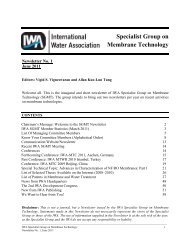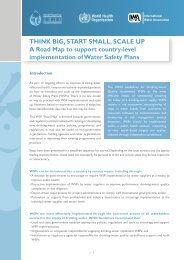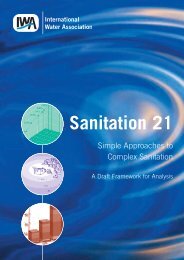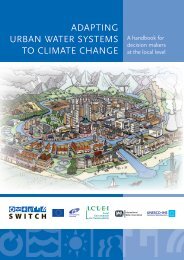Water and Energy - Draft Report of the GWRC Research ... - IWA
Water and Energy - Draft Report of the GWRC Research ... - IWA
Water and Energy - Draft Report of the GWRC Research ... - IWA
You also want an ePaper? Increase the reach of your titles
YUMPU automatically turns print PDFs into web optimized ePapers that Google loves.
AVR, Ne<strong>the</strong>rl<strong>and</strong>s. The AVR pilot is expected to fur<strong>the</strong>r link up <strong>the</strong> gap towards targeted<br />
performance parameters. Keppel Seghers intends to build a second Memstill pilot plant in<br />
Singapore to fur<strong>the</strong>r its underst<strong>and</strong>ing <strong>and</strong> experience with Memstill technology <strong>and</strong> hopefully to<br />
demonstrated an improved performance.<br />
Ongoing projects<br />
Membrane Bioreactor (Demo Plant) – in progress<br />
Baseline performance is being established. The plant has been in operation since Dec 06 <strong>and</strong><br />
have stable operations at membrane flux <strong>of</strong> 25L/m2-h <strong>and</strong> energy consumption between 0.5 - 0.6<br />
kWh/m3. This is lower by 0.3 kWh/m3 compare to <strong>the</strong> normal operation <strong>of</strong> MBR.<br />
The 0.55 kWh/m3 includes <strong>the</strong> energy required by:<br />
• Drum screen<br />
• Blower for membrane<br />
• Blower for aerobic tank<br />
• Pump for sludge supply from aerobic tank to membrane tank<br />
• Pump for sludge circulation from aerobic tank to anoxic tank<br />
• Pump for membrane filtration<br />
• Permeate pump which pumps <strong>the</strong> MBR permeate to <strong>the</strong> product tank which is approx. 400<br />
meter from <strong>the</strong> MBR plant.<br />
• Valves<br />
• Measurement equipment<br />
• <strong>Energy</strong> consumption for <strong>the</strong> MBR control building (air-con, lightings etc).<br />
It does not include:<br />
• Raw water pump<br />
• Pumping energy usage to <strong>the</strong> industrial users after <strong>the</strong> product tank.<br />
Desalination Facility Design <strong>and</strong> Operation for Maximum <strong>Energy</strong> Efficiency (AwwaRF<br />
Project 4038) – in progress<br />
On July 2006, PUB has agreed to participate in this project toge<strong>the</strong>r with Black & Veatch (lead<br />
agent). PUB will contribute as a participating utility. The energy usage at PUB desalination plant<br />
(SingSpring Desalination Plant) will be assessed <strong>and</strong> if required, will be visited for an evaluation<br />
<strong>of</strong> energy balance within various treatment processes. Any potential means <strong>of</strong> improving<br />
efficiency specific to <strong>the</strong> utility will be identified. The results will be used to develop general<br />
guidelines for similar facilities in future. The project is currently on going.<br />
Sludge Drying using Pulver Dryer – in progress<br />
PUB is currently testbedding a Three-Stage PulverDryer system to dry <strong>and</strong> resize municipal<br />
sewage sludge. This material is approximately 20% solids <strong>and</strong> 80% moisture. It is very sticky<br />
<strong>and</strong> hard to h<strong>and</strong>le. The PulverDryer test unit is designed to mix <strong>the</strong> raw materials with dried<br />
materials at about 50% to 50%. That material is <strong>the</strong>n processed through a three stage<br />
PulverDryer System that will reduce to total moisture <strong>of</strong> <strong>the</strong> final product between 65 to 75%<br />
solids. The drying <strong>and</strong> resizing <strong>of</strong> <strong>the</strong> material within <strong>the</strong> PulverDryer allows <strong>the</strong> PUB to rethink<br />
traditional methods <strong>of</strong> disposing <strong>the</strong> material in a l<strong>and</strong>fill. Proper processing <strong>of</strong> this material in<br />
<strong>the</strong> PulverDryer also kills pathogens to EPA levels so <strong>the</strong> final product can be classified as<br />
fertilizer or disposed <strong>of</strong> in a much more inert state in a l<strong>and</strong>fill. This material can also be<br />
<strong>GWRC</strong> <strong>Water</strong> & <strong>Energy</strong> - <strong>Draft</strong> report<br />
55

















